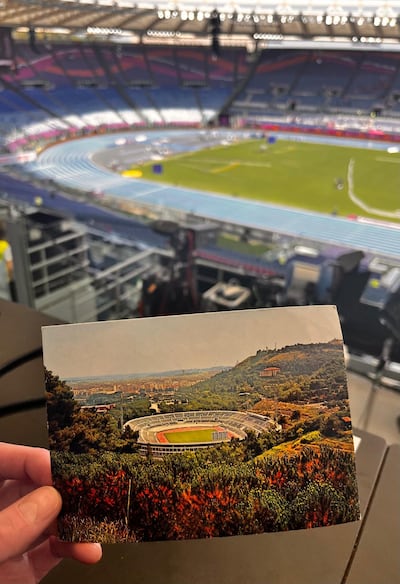It feels like I’ve been here before. It was in another time, and only in my mind, and yet something and everything about walking inside the Stadio Olimpico this week felt utterly familiar.
Some sporting arenas strike you with their sense of scale and design, and others have more personal and profound statements to make. The Stadio Olimpico doesn’t quite have the sheer majesty of say Berlin’s Olympiastadion, built originally for the 1936 Olympics, complete with 40,000 cubic yards of Germany’s finest marble, granite and travertine, and where if the ghost of Adolf Hitler doesn’t get you first, then the ghost of Jesse Owens will.
There is however no doubting what l’Olimpico, as it’s known around here, was drawn from, and it’s that other elliptical amphitheatre built 2,000 years before just a little further down the Tiber. In certain sections, and especially the grand entrance, it is certainly Colosseum-esque. And there is a magnificently haunted air about the place too, as if channelling the spirit of Caesar and Augustus and Vespasian themselves.
The majestic hillside setting in the Foro Italico, and the surrounds filled with Stone Pine and Italian Cypress, Rome’s two signature trees, adds its own special flavour. Though originally built in 1928 and then named the Stadio dei Centomila (given it sat exactly 100,000), it was upgraded and renamed when Rome was awarded the 17th Olympics in the summer of 1960.
READ MORE
The rest is history. Now home to both Roma and Lazio FC, it presently seats a tidy 70,634, the adjacent warm-up track suitably ornamental in its style, the magnificent white canopy roof added before Italia ‘90, and unlike many of the other Olympic arenas built before or since it’s still a living and breathing monument to itself.
My dad sent me a postcard of the stadium from when he was here 50 years ago, covering the 12th edition of the European Athletics Championships, staged in the summer of 1974. That wasn’t too long after he’d run in these championships himself, in the 5,000m in Budapest in 1966, when the small Irish team also included Noel Carroll and Derek McClean, both in the 800m, and Frank Murphy in the 1,500m.

At that point, Ireland had only ever won two European medals, even though the championships had been first staged in Turin in 1934. At the time Ireland had two of the best athletes in the world, reigning Olympic champions Dr Pat O’Callaghan, in the hammer, and Bob Tisdall, in the 400m hurdles. But neither athlete would get a chance to compete on the European stage, as the IAAF at the time banned the Irish Athletics Federation over the thorny issue of whether the country consisted of 26 or 32 counties.
European medals eventually came along with Ronnie Delany winning 1,500m bronze in 1958, two years after his Olympic triumph in Melbourne, before Murphy won silver in the 1,500m in Athens in 1969.
Truth is there wasn’t much for my dad to write home about from l’Olimpico 50 years ago. Neil Cusack was fancied to medal in the marathon, having won the famed Boston marathon a few months before, but he ended up finishing eighth, the experienced British runner Ian Thompson winning gold.
A 21-year-old Eamonn Coghlan, who had just missed out on the 1,500m qualifying time, was instead entered for the 5,000m, essentially for the experience. Coghlan finished last in his heat, but soon enough put that experience to good use, winning a 1,500m silver four years later, in 1978. Three years after that, Coghlan was back inside the l’Olimpico and won the IAAF World Cup 5,000m
When the 1987 World Athletics Championships were staged here in the Stadio Olimpico we were glued to every single event with wonder and curiosity. Ben Johnson beating Carl Lewis in the 100m (we all remember what happened next), Said Aouita from Morocco winning the 5,000m, Abdi Bile from Somalia stunning everyone in the 1,500m. I could go on.
We’d also watched in awe earlier that summer, when at a 1987 Golden Gala meeting inside l’Olimpico, Aouita became the first man in history to run 5,000m in under 13 minutes, clocking 12:58.39. The Golden Gala produced several more world records since, Hicham El Guerrouj also from Morocco running 3:26.00 for 1,500m here in 1998, and the mile in 3:43.13 in 1999 – both those records still stand.
It feels like I’ve been here before. I brought along that postcard sent from l’Olimpico in 1974, as a reminder of how memories are made.














